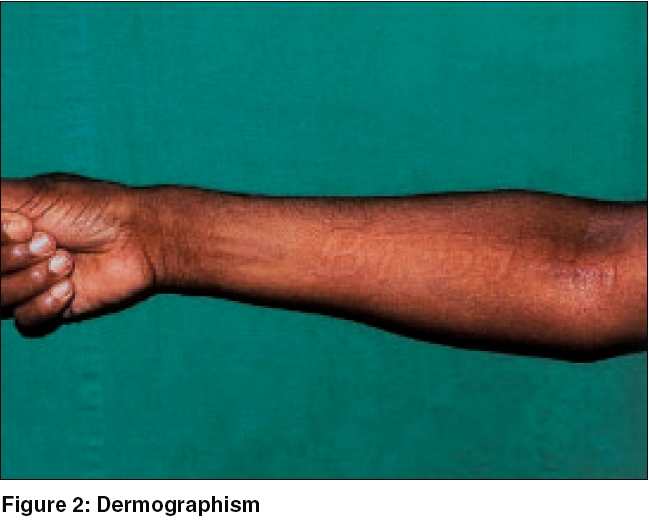Translate this page into:
Scleroderma and dermographism in a case of carcinoma ovary
Correspondence Address:
P Parikh
Professor & Head Department of Medical Oncology, Tata Memorial Hospital, Parel, Mumbai - 400012
India
| How to cite this article: Vottery R, Biswas G, Deshmukh C, Gupta S, Nair R, Parikh P. Scleroderma and dermographism in a case of carcinoma ovary. Indian J Dermatol Venereol Leprol 2005;71:429-430 |
 |
 |
 |
 |
Sir,
Cutaneous paraneoplastic syndromes are rare manifestations of epithelial ovarian cancer. Dermatomyositis.[1] acanthosis nigricans, systemic lupus erythematosus (SLE), and scleroderma have been well described. A syndrome of palmar fasciitis and polyarthritis associated with endometroid carcinoma of the ovary, termed "reflex sympathetic dystrophy" is also known.[2]
A 43-year-old previously healthy lady having two children presented with generalized pruritus and urticaria of six months duration. This was associated with disfiguring hyperpigmentation involving the face, anterior abdominal wall, and the popliteal regions. She also started experiencing difficulty in clenching the fist due to marked skin thickening. She had noticed a mass in the lower abdomen one month prior to the presentation. She underwent a staging laparotomy with a suboptimal debulking of the ovarian mass elsewhere, and was subsequently referred to our center.
She denied a history of recurrent aphthous ulcers, Raynaud′s phenomenon, or proximal myopathy. There was no past or family history of autoimmune disorders, atopy and physical urticaria. She received antihistaminics for pruritus. However the pressure urticaria persisted.
Examination revealed a well-nourished lady having a left scalene node 1 cm in size and an inguinal node of 3 cm. She had sclerodactyly. Thick sclerosed skin was noted in the popliteal fossa, lower abdomen, thighs, and dorsal aspect of the hands. Symmetrical brownish black hyperpigmented irregular patches were evident over the elbows, shoulders, ankles, upper trunk, and popliteal regions [Figure - 1]. There was prominent dermographism [Figure - 2]. There were no telangiectasias. The rest of the examination was unremarkable.
Investigations revealed a normal hemogram and biochemical profile, including serum LDH and CPK. The serum CA-125 was 650 u/ml (the upper limit of normal being 35 u/ml). Serum antinuclear antibodies (ANA) were negative. The preoperative CT scan revealed a 14 x 9 cm abdomino-pelvic mass, multiple retroperitoneal lymph nodes (the largest measuring 1.5 cm), and minimal ascites. The histology of the specimen was that of a moderately differentiated papillary serous cystadenocarcinoma. A biopsy of the sclerosed skin was not diagnostic of any specific pathology.
She was administered chemotherapy comprising paclitaxel 175mg/m2 and carboplatin to AUC 6 every 3 weeks. No specific therapy was offered for the cutaneous problems. Following three cycles, the hyperpigmentation dramatically regressed, the skin became softer, and the episodic urticaria resolved. She could now easily clench a fist. After six cycles of chemotherapy, the abdominal and pelvis CT scan and CA 125 were normal. At 6 months post-treatment, the scleroderma has almost completely resolved and dermographism is absent. She is on regular follow up.
Several case reports describe the occurrence of rare cutaneous paraneoplastic syndromes in patients known to have carcinoma of the ovary. Our case is unique because the patient had a combination of three dermatological signs, including dermographism. Mastocytosis,[3] atopy,[4] and rarely Helicobacter pylori infection and familial dermographism have been reported as causes of pressure urticaria.[5] We could not find any report of paraneoplastic dermographism associated with malignancy. A temporal association between these dermatological manifestations and ovarian cancer, followed by clearcut regression with tumor directed chemotherapy confirms the paraneoplastic origin of the skin manifestations in this case.
| 1. |
Barnes BE, Mawr B. Dermatomyositis and malignancy. A review of the literature. Ann Intern Med 1976:84;68-76.
[Google Scholar]
|
| 2. |
Requena L, Aguilar A, Renedo G, Martin L, Pique E, Farina MC, et al. Tripe palms: A cutaneous marker of internal malignancy. J Dermatol 1995:22;492-5.
[Google Scholar]
|
| 3. |
Mestre-Deharo C, Sayag J. Urticaria and angioedema caused by mastocytosis. Allerg Immunol 1993:25;344-5.
[Google Scholar]
|
| 4. |
Margolis CF, Estes SA. Symptomatic dermographism. J Fam Pract 1981:13;993-5.
[Google Scholar]
|
| 5. |
Jedele KB, Michels VV. Familial dermographism. Am J Med Genet 1991:39;201-3.
[Google Scholar]
|
Fulltext Views
3,148
PDF downloads
882





